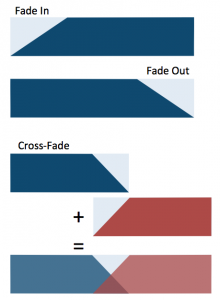Project 1 due Monday, January 24, 2022 by 11:59PM Eastern
Peer grading due by Monday, January 31, 2022 by 11:59PM
Fade In, Fade Out, Cross-Fade
You should be familiar with the terms fade in, fade out, and cross-fade. As a reminder, here’s a schematic to illustrate these terms. Remember that, when incorporating sounds into compositions, any sound without a “natural” beginning and ending should be edited with a fade in and fade out to avoid clicks and pops at the beginning and ending. When joining sounds together, one often overlaps the fade out of one sound with the fade in of the next sound, creating a cross-fade.

Project Instructions
We recommend that you create a director/folder on your computer for Project 1 and store all of your files and subdirectories/subfolders in this location. You will then zip the project folder when you are ready to submit. Do not name the folder in a way that will identify yourself.
- Obtain one or more sounds from freesound.org. (You may also record sounds of your own, including voice.) Store this sound as sound0.wav in your project folder.
- Using a sound between 3 and 5 seconds long, make a 1-second-long cross-fade from the sound to a copy of itself. This means the first copy of the sound will fade-out over 1 second while simultaneously the second copy fades in over 1 second, making the two sounds overlap during this 1 second period. Then, operating on the combined (spliced) sound, fade out over 2 seconds. Store this sound as sound1.wav in your project folder.
- Using the same original sound source, make a 20-ms-long cross-fade from the sound to a copy of itself. Then, operating on the combined (spliced) sound, fade out over 100 ms. Store this sound as sound2.wav in your project folder.
- Use Audacity (or another audio editing tool) to manipulate your sounds using splicing, mixing, and any effects you wish. The final mix should have a duration of 30 to 60 seconds. Your mix should either be a soundscape — layers of sound with different amplitude, panning, and effects — or a “beat” — a rhythmic sequence that loops. In either case, you should construct something original rather than using a ready-made sound. Use the envelope controls in Audacity to shape the loudness contour. E.g. you can fade in and out, ramp up to a climax, or create rhythm with amplitude change. Some form of loudness control should be obvious in your result. Your composition may be mono or stereo. Store your final mix as comp.wav in your project folder, and store the original sounds you used to create the mix in a subfolder called origin. (NOTE: If you have more than 10MB or 1 minute of sound, include representative sounds, keeping the total data in the origin subfolder under 10MB.)
- Write answers to the following questions in the plain text file answer.txt stored in your project folder at its top level. Again, do not write anything that may identify yourself; keep your submission anonymous for peer grading.
- State the duration of your sound from part 4. To help our autograder, type a string exactly in the form: DURATION=37S (Note: all caps including “S”, no spaces, state the decimal integer number of seconds – rounded from the true duration – followed by capital S. The string “DURATION=” should appear only once in the file.)
- Compute the size of the sound file assuming you save the file as a single-channel .wav file with 16-bit samples and a 44kHz sample rate. (Does the number match the true size? If not, think about why not.) To help our autograder, type a string exactly in the form: SIZE=180MB. (Again, all caps, no spaces, state the rounded-to-integer decimal number of megabytes – 1,000,000 bytes = 1MB – and “SIZE=” should appear only once with your answer.)
- What was your intention in the design/composition of your sound?
- Submit your project as a zip file. The following files should be at the top level in your zip file (you may use .aiff sound files instead of .wav sound files):
sound0.wav: original sound used in Part 2 and Part 3
sound1.wav: cross-fade/fade-in/fade-out sound, 1s cross-fade, 2s fade
sound2.wav: cross-fade/fade-in/fade-out sound, 20ms cross-fade, 100ms fade
origin/: a folder that contains the all the original sound files for your composition in Part 4; if you have more than 10MB or 1 minute of sound, include representative sounds, keeping the total data in origin/ under 10MB.
comp.wav: your composition
answers.txt: short answers
comp_README.txt: optional additional info on your composition
origin/README.txt: optional credits and info on your source material - Getting the right files in the right place is crucial. Unzip your zip file into a fresh location and check the resulting directory for each of the files and directories above. For example, your submission could contain the following:
sound0.aiff
sound1.aiff
sound2.aiff
origin/sound.aiff
comp.aiff
comp_README.txt
answers.txt
Grading is based on the following points:
-
- Your submission should be anonymous.
- Your cross-faded sounds should be correctly constructed.
- Your answers for duration and size should be correct.
- Your composition should not have any clipping.
- Your composition should use the Audacity envelope tool or equivalent to make obvious loudness contrasts.
- Your composition should show other editing or processing techniques.
- Your composition should engage the listener.
Peer-grading will be assigned after the due date and will be due Monday, January 31 by 11:59PM Eastern.
